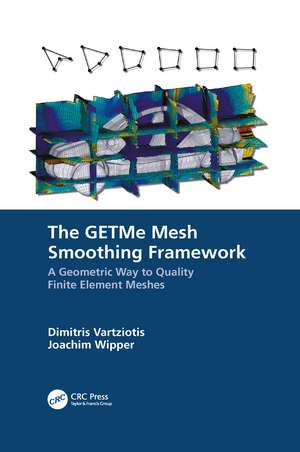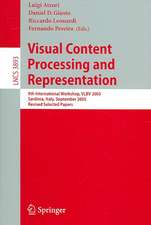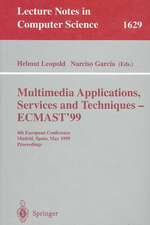The GETMe Mesh Smoothing Framework: A Geometric Way to Quality Finite Element Meshes
Autor Dimitris Vartziotis, Joachim Wipperen Limba Engleză Paperback – 30 iun 2021
The geometric element transformation method (GETMe) aims to fill the gap between these two approaches. It is based on geometric mesh element transformations, which iteratively transform polygonal and polyhedral elements into their regular counterparts or into elements with a prescribed shape. GETMe combines a Laplacian smoothing-like computational efficiency with a global optimization-like effectiveness. The method is straightforward to implement and its variants can also be used to improve tangled and anisotropic meshes.
This book describes the mathematical theory of geometric element transformations as foundation for mesh smoothing. It gives a thorough introduction to GETMe-based mesh smoothing and its algorithms providing a framework to focus on effectively improving key mesh quality aspects. It addresses the improvement of planar, surface, volumetric, mixed, isotropic, and anisotropic meshes and addresses aspects of combining mesh smoothing with topological mesh modification.
The advantages of GETMe-based mesh smoothing are demonstrated by the example of various numerical tests. These include smoothing of real world meshes from engineering applications as well as smoothing of synthetic meshes for demonstrating key aspects of GETMe-based mesh improvement. Results are compared with those of other smoothing methods in terms of runtime behavior, mesh quality, and resulting finite element solution efficiency and accuracy.
Features:
• Helps to improve finite element mesh quality by applying geometry-driven mesh smoothing approaches.
• Supports the reader in understanding and implementing GETMe-based mesh smoothing.
• Discusses aspects and properties of GETMe smoothing variants and thus provides guidance for choosing the appropriate mesh improvement algorithm.
• Addresses smoothing of various mesh types: planar, surface, volumetric, isotropic, anisotropic, non-mixed, and mixed.
• Provides and analyzes geometric element transformations for polygonal and polyhedral elements with regular and non-regular limits.
• Includes a broad range of numerical examples and compares results with those of other smoothing methods.
| Toate formatele și edițiile | Preț | Express |
|---|---|---|
| Paperback (1) | 373.53 lei 6-8 săpt. | |
| CRC Press – 30 iun 2021 | 373.53 lei 6-8 săpt. | |
| Hardback (1) | 619.11 lei 6-8 săpt. | |
| CRC Press – 3 dec 2018 | 619.11 lei 6-8 săpt. |
Preț: 373.53 lei
Preț vechi: 466.91 lei
-20% Nou
Puncte Express: 560
Preț estimativ în valută:
71.48€ • 77.62$ • 60.05£
71.48€ • 77.62$ • 60.05£
Carte tipărită la comandă
Livrare economică 22 aprilie-06 mai
Preluare comenzi: 021 569.72.76
Specificații
ISBN-13: 9781032094250
ISBN-10: 1032094257
Pagini: 264
Ilustrații: 112 Illustrations, black and white
Dimensiuni: 156 x 234 x 14 mm
Greutate: 0.37 kg
Ediția:1
Editura: CRC Press
Colecția CRC Press
ISBN-10: 1032094257
Pagini: 264
Ilustrații: 112 Illustrations, black and white
Dimensiuni: 156 x 234 x 14 mm
Greutate: 0.37 kg
Ediția:1
Editura: CRC Press
Colecția CRC Press
Cuprins
Introduction. Elements and Meshes. The Finite Element Method. Mesh Improvement. Regularizing Element Transformations. The GETMe Smoothing Framework. Numerical examples. Extending the GETMe Framework. References. Index.
Notă biografică
Dr. Dimitris Vartziotis studied Aeronautical and Space Engineering (MSc) (Prof. John
Argyris) and Civil Engineering (MSc). He carried out his PhD Thesis in Computational
Mechanics. He worked as a scientific executive in IBM Germany. He founded and
manages the companies ΝΙΚΙ ΜΕΠΕ and TWT GmbH. TWT GmbH has been awarded
first place for innovation and overall evaluation amongst the top German automotive
companies. His research focuses on scientific technology and theoretical Mathematics.
He publishes in international scientific journals of publishing houses such as Elsevier
and Springer. Moreover, he is a reviewer for the European Mathematical Society
(zbMATH) and the American Mathematical Society (AMS).
Dr. Joachim Wipper studied mathematics and computer sciences with an emphasis on
numerical mathematics and computer aided geometric design. From 1999 he worked as
scientific employee at the Mathematical Institute of Stuttgart University and earned his
doctorate degree in 2005 working on a spline based finite element method. In 2006 he
changed to TWT GmbH Science & Innovation working on industrial and research
projects covering engineering and mathematical topics. Since 2013 he is employed in
the Research & Development department of TRUMPF Werkzeugmaschinen GmbH &
Co. KG.
Argyris) and Civil Engineering (MSc). He carried out his PhD Thesis in Computational
Mechanics. He worked as a scientific executive in IBM Germany. He founded and
manages the companies ΝΙΚΙ ΜΕΠΕ and TWT GmbH. TWT GmbH has been awarded
first place for innovation and overall evaluation amongst the top German automotive
companies. His research focuses on scientific technology and theoretical Mathematics.
He publishes in international scientific journals of publishing houses such as Elsevier
and Springer. Moreover, he is a reviewer for the European Mathematical Society
(zbMATH) and the American Mathematical Society (AMS).
Dr. Joachim Wipper studied mathematics and computer sciences with an emphasis on
numerical mathematics and computer aided geometric design. From 1999 he worked as
scientific employee at the Mathematical Institute of Stuttgart University and earned his
doctorate degree in 2005 working on a spline based finite element method. In 2006 he
changed to TWT GmbH Science & Innovation working on industrial and research
projects covering engineering and mathematical topics. Since 2013 he is employed in
the Research & Development department of TRUMPF Werkzeugmaschinen GmbH &
Co. KG.
Descriere
This book describes the mathematical theory of regularizing element transformations as foundation for mesh smoothing. It gives a thorough introduction to GETMe based mesh smoothing and its algorithms providing a framework to focus on efficiently improving minimal element quality, overal mesh quality, and mesh validity.




















